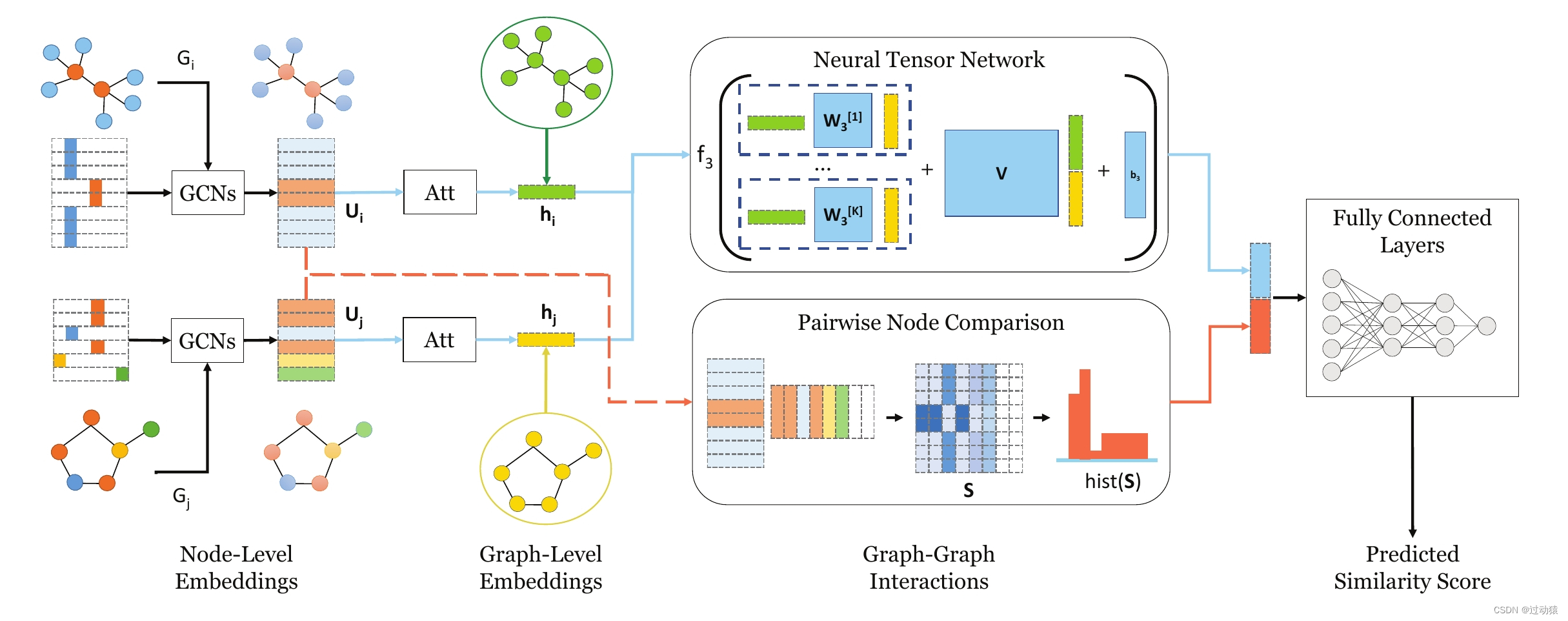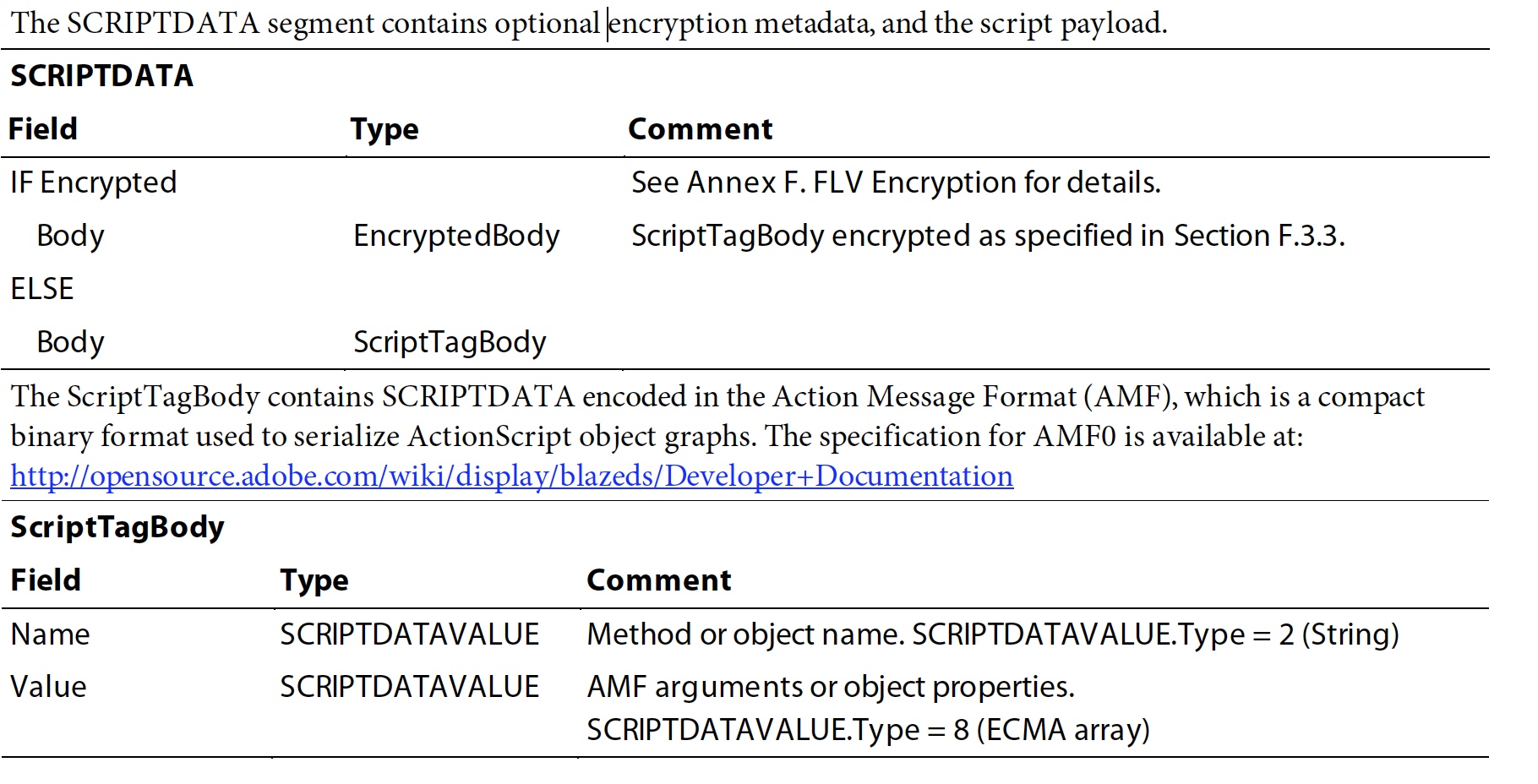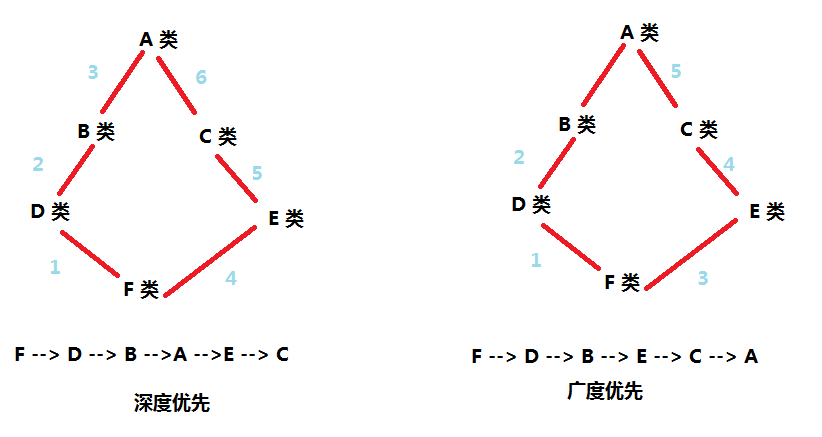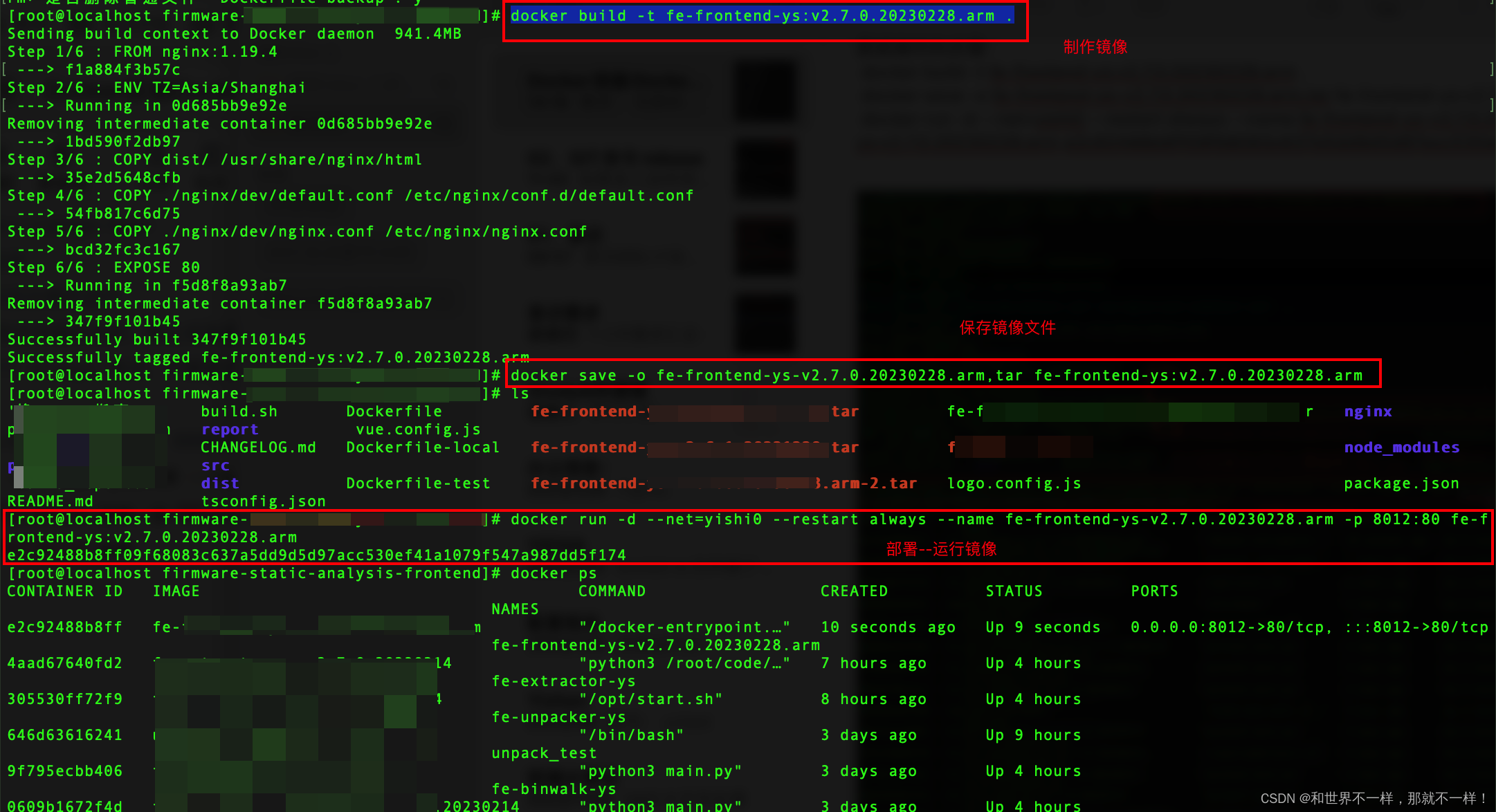文章目录
- SimGNN:快速图相似度计算的神经网络方法
- 1. 数据
- 2. 模型
- 2.1 python文件功能介绍
- 2.2 重要函数和类的实现
SimGNN:快速图相似度计算的神经网络方法
原论文名称:SimGNN: A Neural Network Approach to Fast Graph Similarity Computation
代码链接:https://github.com/benedekrozemberczki/SimGNN
1. 数据
例子:
{"graph_1": [[0, 8], [0, 9], [0, 2], [0, 3], [0, 11], [1, 2], [1, 3], [1, 5], [1, 6], [1, 7], [2, 3], [2, 5], [2, 6], [2, 7], [2, 8], [2, 10], [2, 11], [3, 5], [3, 7], [3, 8], [3, 10], [3, 11], [4, 9], [4, 10], [4, 5], [4, 6], [4, 7], [5, 7], [5, 8], [5, 11], [6, 7], [6, 8], [6, 11], [7, 8], [7, 10], [7, 11], [8, 9], [10, 11]], "ged": 32, "graph_2": [[0, 1], [0, 2], [0, 4], [1, 8], [1, 10], [1, 2], [1, 7], [2, 4], [2, 7], [2, 9], [2, 11], [3, 10], [3, 11], [3, 5], [3, 6], [3, 7], [4, 9], [4, 11], [5, 8], [5, 9], [5, 6], [6, 9], [7, 9], [7, 10], [7, 11], [8, 9], [8, 10], [9, 10], [9, 11], [10, 11]], "labels_2": ["3", "5", "6", "5", "4", "4", "3", "6", "4", "8", "6", "6"], "labels_1": ["5", "5", "9", "8", "5", "7", "6", "9", "7", "3", "5", "7"]}
一个样本包含五个属性:
graph_1:graph1的邻接矩阵
graph_2:graph2的邻接矩阵
labels_1:graph1的特征矩阵
labels_2:graph2的特征矩阵
ged:图相似度
2. 模型

2.1 python文件功能介绍
layers.py -- 包含注意力机制层和Neural Tensor Network层的实现
simgnn.py -- 模型实现
utils.py -- 一些辅助函数的实现
param_parser.py -- 参数
main.py -- 主函数
--filters-1 INT Number of filter in 1st GCN layer. Default is 128.
--filters-2 INT Number of filter in 2nd GCN layer. Default is 64.
--filters-3 INT Number of filter in 3rd GCN layer. Default is 32.
--tensor-neurons INT Neurons in tensor network layer. Default is 16.
--bottle-neck-neurons INT Bottle neck layer neurons. Default is 16.
--bins INT Number of histogram bins. Default is 16.
--batch-size INT Number of pairs processed per batch. Default is 128.
--epochs INT Number of SimGNN training epochs. Default is 5.
--dropout FLOAT Dropout rate. Default is 0.5.
--learning-rate FLOAT Learning rate. Default is 0.001.
--weight-decay FLOAT Weight decay. Default is 10^-5.
--histogram BOOL Include histogram features. Default is False.
2.2 重要函数和类的实现
- 注意力机制层
- __init__初始化函数
功能:
导入需要的参数:args;
设置参数矩阵,形状为[self.args.filters_3,self.args.filters_3]:调用setup_weights(),
初始化参数矩阵的值:调用init_parameters()
def __init__(self, args):
"""
:param args: Arguments object.
"""
super(AttentionModule, self).__init__()
self.args = args
self.setup_weights()
self.init_parameters()
- setup_weights函数
def setup_weights(self):
"""
Defining weights.
"""
self.weight_matrix = torch.nn.Parameter(torch.Tensor(self.args.filters_3,
self.args.filters_3))
- init_parameters函数
def init_parameters(self):
"""
Initializing weights.
"""
torch.nn.init.xavier_uniform_(self.weight_matrix)
- forward函数
'''
key: embedding
value: embedding
query: embedding_i
'''
def forward(self, embedding): # embedding形状:[graph_node_num, self.args.filters_3]
"""
Making a forward propagation pass to create a graph level representation.
:param embedding: Result of the GCN.
:return representation: A graph level representation vector.
"""
global_context = torch.mean(torch.matmul(embedding, self.weight_matrix), dim=0) # [1,self.args.filters_3]
transformed_global = torch.tanh(global_context) # [1, self.args.filters_3]
sigmoid_scores = torch.sigmoid(torch.mm(embedding, transformed_global.view(-1, 1))) # [graph_node_num, 1]
representation = torch.mm(torch.t(embedding), sigmoid_scores) # [self.args.filters_3, 1]
return representation
整体代码:
class AttentionModule(torch.nn.Module):
"""
SimGNN Attention Module to make a pass on graph.
"""
def __init__(self, args):
"""
:param args: Arguments object.
"""
super(AttentionModule, self).__init__()
self.args = args
self.setup_weights()
self.init_parameters()
def setup_weights(self):
"""
Defining weights.
"""
self.weight_matrix = torch.nn.Parameter(torch.Tensor(self.args.filters_3,
self.args.filters_3))
def init_parameters(self):
"""
Initializing weights.
"""
torch.nn.init.xavier_uniform_(self.weight_matrix)
def forward(self, embedding):
"""
Making a forward propagation pass to create a graph level representation.
:param embedding: Result of the GCN.
:return representation: A graph level representation vector.
"""
global_context = torch.mean(torch.matmul(embedding, self.weight_matrix), dim=0)
transformed_global = torch.tanh(global_context)
sigmoid_scores = torch.sigmoid(torch.mm(embedding, transformed_global.view(-1, 1)))
representation = torch.mm(torch.t(embedding), sigmoid_scores)
return representation
- Neural Tensor Network层
class TenorNetworkModule(torch.nn.Module):
"""
SimGNN Tensor Network module to calculate similarity vector.
"""
def __init__(self, args):
"""
:param args: Arguments object.
"""
super(TenorNetworkModule, self).__init__()
self.args = args
self.setup_weights()
self.init_parameters()
def setup_weights(self):
"""
Defining weights.
"""
self.weight_matrix = torch.nn.Parameter(torch.Tensor(self.args.filters_3,
self.args.filters_3,
self.args.tensor_neurons))
self.weight_matrix_block = torch.nn.Parameter(torch.Tensor(self.args.tensor_neurons,
2*self.args.filters_3))
self.bias = torch.nn.Parameter(torch.Tensor(self.args.tensor_neurons, 1))
def init_parameters(self):
"""
Initializing weights.
"""
torch.nn.init.xavier_uniform_(self.weight_matrix)
torch.nn.init.xavier_uniform_(self.weight_matrix_block)
torch.nn.init.xavier_uniform_(self.bias)
def forward(self, embedding_1, embedding_2):
# embedding_1:[self.args.filters_3, 1]
# embedding_2:[self.args.filters_3, 1]
"""
Making a forward propagation pass to create a similarity vector.
:param embedding_1: Result of the 1st embedding after attention.
:param embedding_2: Result of the 2nd embedding after attention.
:return scores: A similarity score vector.
"""
scoring = torch.mm(torch.t(embedding_1), self.weight_matrix.view(self.args.filters_3, -1)) # [1, self.args.filters_3*self.args.tensor_neurons]
scoring = scoring.view(self.args.filters_3, self.args.tensor_neurons) # [self.args.filters_3, self.args.tensor_neurons]
scoring = torch.mm(torch.t(scoring), embedding_2) # [self.args.tensor_neurons, 1]
combined_representation = torch.cat((embedding_1, embedding_2)) # [2*self.args.filters_3, 1]
block_scoring = torch.mm(self.weight_matrix_block, combined_representation) # [self.args.tensor_neurons, 1]
scores = torch.nn.functional.relu(scoring + block_scoring + self.bias) # [self.args.tensor_neurons, 1]
return scores
- SimGNN模型
- __init__初始化函数:
功能:导入需要用到的参数:args,label数量:number_of_labels,构建模型:调用setup_layers函数
def __init__(self, args, number_of_labels):
"""
:param args: Arguments object.
:param number_of_labels: Number of node labels.
"""
super(SimGNN, self).__init__()
self.args = args
self.number_labels = number_of_labels # 存放label种类数量
self.setup_layers()
- calculate_bottleneck_features函数:
功能:是否要加上histogram层(下半部分)提取的embedding
def calculate_bottleneck_features(self):
"""
Deciding the shape of the bottleneck layer.
"""
if self.args.histogram == True:
self.feature_count = self.args.tensor_neurons + self.args.bins
else:
self.feature_count = self.args.tensor_neurons
- setup_layers函数:
功能:构建模型,包括三个图卷积层,自注意力机制层,Neural Tensor Network层,两个线性层,最后输出一个预测的值。
def setup_layers(self):
"""
Creating the layers.
"""
self.calculate_bottleneck_features()
self.convolution_1 = GCNConv(self.number_labels, self.args.filters_1)
self.convolution_2 = GCNConv(self.args.filters_1, self.args.filters_2)
self.convolution_3 = GCNConv(self.args.filters_2, self.args.filters_3)
self.attention = AttentionModule(self.args)
self.tensor_network = TenorNetworkModule(self.args)
self.fully_connected_first = torch.nn.Linear(self.feature_count,
self.args.bottle_neck_neurons)
self.scoring_layer = torch.nn.Linear(self.args.bottle_neck_neurons, 1)
- calculate_histogram函数:
def calculate_histogram(self, abstract_features_1, abstract_features_2):
"""
Calculate histogram from similarity matrix.
:param abstract_features_1: Feature matrix for graph 1.
:param abstract_features_2: Feature matrix for graph 2.
:return hist: Histsogram of similarity scores.
"""
scores = torch.mm(abstract_features_1, abstract_features_2).detach()
scores = scores.view(-1, 1)
hist = torch.histc(scores, bins=self.args.bins)
hist = hist/torch.sum(hist)
hist = hist.view(1, -1)
return hist
- convolutional_pass函数:
def convolutional_pass(self, edge_index, features):
"""
Making convolutional pass.
:param edge_index: Edge indices.
:param features: Feature matrix.
:return features: Absstract feature matrix.
"""
features = self.convolution_1(features, edge_index)
features = torch.nn.functional.relu(features)
features = torch.nn.functional.dropout(features,
p=self.args.dropout,
training=self.training)
features = self.convolution_2(features, edge_index)
features = torch.nn.functional.relu(features)
features = torch.nn.functional.dropout(features,
p=self.args.dropout,
training=self.training)
features = self.convolution_3(features, edge_index)
return features
- forward函数:
功能:运行神经网络,预测结果
def forward(self, data):
"""
Forward pass with graphs.
:param data: Data dictiyonary.
:return score: Similarity score.
"""
edge_index_1 = data["edge_index_1"]
edge_index_2 = data["edge_index_2"]
features_1 = data["features_1"]
features_2 = data["features_2"]
# 图卷积的计算
abstract_features_1 = self.convolutional_pass(edge_index_1, features_1) # [graph1_num_node,self.args.filters_3]
abstract_features_2 = self.convolutional_pass(edge_index_2, features_2) # [graph2_num_node,self.args.filters_3]
# 计算histogram
if self.args.histogram == True:
hist = self.calculate_histogram(abstract_features_1,
torch.t(abstract_features_2))
# 使用注意力机制层
pooled_features_1 = self.attention(abstract_features_1)
pooled_features_2 = self.attention(abstract_features_2)
scores = self.tensor_network(pooled_features_1, pooled_features_2) # [self.args.tensor_neurons, 1]
scores = torch.t(scores) # [1,self.args.tensor_neurons]
# 合并注意力机制层和Neural Tensor Network层提取的特征
if self.args.histogram == True:
scores = torch.cat((scores, hist), dim=1).view(1, -1) # [1, self.feature_count]
# 获得预测分数,由于标准答案使用了归一化,所以最后要过一下sigmoid层
scores = torch.nn.functional.relu(self.fully_connected_first(scores)) # [1, self.args.bottle_neck_neurons]
score = torch.sigmoid(self.scoring_layer(scores)) # self.scoring_layer(scores): [1,1]
return score
整体代码:
class SimGNN(torch.nn.Module):
"""
SimGNN: A Neural Network Approach to Fast Graph Similarity Computation
https://arxiv.org/abs/1808.05689
"""
def __init__(self, args, number_of_labels):
"""
:param args: Arguments object.
:param number_of_labels: Number of node labels.
"""
super(SimGNN, self).__init__()
self.args = args
self.number_labels = number_of_labels
self.setup_layers()
def calculate_bottleneck_features(self):
"""
Deciding the shape of the bottleneck layer.
"""
if self.args.histogram == True:
self.feature_count = self.args.tensor_neurons + self.args.bins
else:
self.feature_count = self.args.tensor_neurons
def setup_layers(self):
"""
Creating the layers.
"""
self.calculate_bottleneck_features()
self.convolution_1 = GCNConv(self.number_labels, self.args.filters_1)
self.convolution_2 = GCNConv(self.args.filters_1, self.args.filters_2)
self.convolution_3 = GCNConv(self.args.filters_2, self.args.filters_3)
self.attention = AttentionModule(self.args)
self.tensor_network = TenorNetworkModule(self.args)
self.fully_connected_first = torch.nn.Linear(self.feature_count,
self.args.bottle_neck_neurons)
self.scoring_layer = torch.nn.Linear(self.args.bottle_neck_neurons, 1)
def calculate_histogram(self, abstract_features_1, abstract_features_2):
"""
Calculate histogram from similarity matrix.
:param abstract_features_1: Feature matrix for graph 1.
:param abstract_features_2: Feature matrix for graph 2.
:return hist: Histsogram of similarity scores.
"""
scores = torch.mm(abstract_features_1, abstract_features_2).detach()
scores = scores.view(-1, 1)
hist = torch.histc(scores, bins=self.args.bins)
hist = hist/torch.sum(hist)
hist = hist.view(1, -1)
return hist
def convolutional_pass(self, edge_index, features):
"""
Making convolutional pass.
:param edge_index: Edge indices.
:param features: Feature matrix.
:return features: Absstract feature matrix.
"""
features = self.convolution_1(features, edge_index)
features = torch.nn.functional.relu(features)
features = torch.nn.functional.dropout(features,
p=self.args.dropout,
training=self.training)
features = self.convolution_2(features, edge_index)
features = torch.nn.functional.relu(features)
features = torch.nn.functional.dropout(features,
p=self.args.dropout,
training=self.training)
features = self.convolution_3(features, edge_index)
return features
def forward(self, data):
"""
Forward pass with graphs.
:param data: Data dictiyonary.
:return score: Similarity score.
"""
edge_index_1 = data["edge_index_1"]
edge_index_2 = data["edge_index_2"]
features_1 = data["features_1"]
features_2 = data["features_2"]
# 图卷积的计算
abstract_features_1 = self.convolutional_pass(edge_index_1, features_1) # [graph1_num_node,self.args.filters_3]
abstract_features_2 = self.convolutional_pass(edge_index_2, features_2) # [graph2_num_node,self.args.filters_3]
# 计算histogram
if self.args.histogram == True:
hist = self.calculate_histogram(abstract_features_1,
torch.t(abstract_features_2))
# 使用注意力机制层
pooled_features_1 = self.attention(abstract_features_1)
pooled_features_2 = self.attention(abstract_features_2)
scores = self.tensor_network(pooled_features_1, pooled_features_2) # [self.args.tensor_neurons, 1]
scores = torch.t(scores) # [1,self.args.tensor_neurons]
# 合并注意力机制层和Neural Tensor Network层提取的特征
if self.args.histogram == True:
scores = torch.cat((scores, hist), dim=1).view(1, -1) # [1, self.feature_count]
# 获得预测分数,由于标准答案使用了归一化,所以最后要过一下sigmoid层
scores = torch.nn.functional.relu(self.fully_connected_first(scores)) # [1, self.args.bottle_neck_neurons]
score = torch.sigmoid(self.scoring_layer(scores)) # self.scoring_layer(scores): [1,1]
return score



















